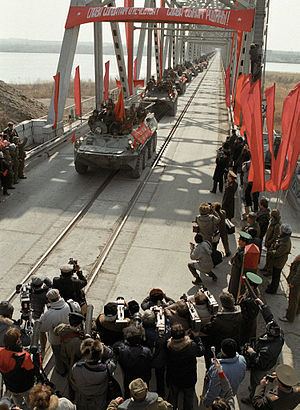523 killed 1,200 killed Combatants Soviet Union, Mujahideen | Dates 15 May 1988 – 15 Feb 1989 | |
 | ||
Result Successful Soviet withdrawal from Afghanistan Similar Soviet–Afghan War, Saur Revolution, Operation Storm‑333, War in Afghanistan, Withdrawal of US troops fro | ||
Soviet withdrawal from afghanistan 1988
The withdrawal of Soviet combatant forces from Afghanistan began on 15 May 1988 and successfully executed on 15 February 1989 under the leadership of Colonel-General Boris Gromov who also was the last Soviet general officer to walk from Afghanistan back into Soviet territory through the Afghan-Uzbek Bridge.
Contents
Events
Under the Geneva Accords on 14 April 1988, Afghanistan and Pakistan signed three instruments-on principles of mutual relations, in particular non-interference and non-intervention, on the voluntary return of Afghan refugees, and on interrelationships for the settlement, which provided for phased withdrawal of foreign soldiers to begin on 15 May. The United States and the Soviet Union also signed a declaration on international guarantees, stating they would both refrain from any form of interference and intervention.
In the first three-month period, it was reported that some 50,183 foreign soldiers had withdrawn. Another 50,100 left between 15 August 1988 and 15 February 1989.
During the process of withdrawal, Soviet troop convoys came under attack by Afghan fighters. In all 523 Soviet soldiers and 1,200 Mujahedeen fighters were killed during the withdrawal.
The total withdrawal of all Soviet soldiers from Afghanistan was completed on 15 February 1989, in compliance with the terms of the Geneva Accords signed 10 months earlier.
In a symbolic move, Lt. Gen. Boris Gromov was the last to walk from Afghanistan back into Soviet territory.
